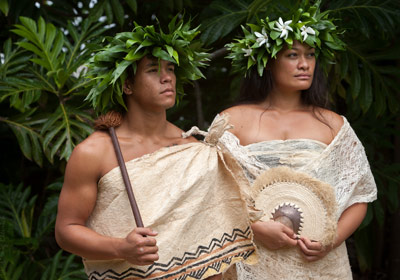 “‘Ulu [kapa] is from way back,” says master kapa maker Wesley Sen. “It can be made in less than an hour, which would be necessary for commoners. The ali‘i preferred wauke, which could be decorated.”
“‘Ulu [kapa] is from way back,” says master kapa maker Wesley Sen. “It can be made in less than an hour, which would be necessary for commoners. The ali‘i preferred wauke, which could be decorated.”
Around the same time Diane Ragone was poking around Polynesia for breadfruit varieties, Sen was researching the disappearing art of Hawaiian kapa-making with his colleague, Puanani Van Dorpe. They knew Hawaiians once made ‘ulu cloth, but they couldn’t locate anyone living who knew how to do it. So Sen gave it his best shot: fermenting ‘ulu bark, beating it into thin sheets, and applying the traditional watermarks. His finished product lives at Bishop Museum, the state’s repository of cultural artifacts.
Recently Sen hosted an ‘ulu kapa workshop at the Bailey Museum in Wailuku. First, he and his participants harvested ‘ulu bark from Kahanu Gardens, and kukui-tree roots from ‘Iao Valley for dye. Then they recreated the clothing of their forebears. Photos of the event reveal a remarkable diversity in texture and appearance.
“When you show Hawaiians an image of [themselves] standing regal in authentic costumes, they go, ‘Ahhhh . . . that’s how we were. That’s how we are.’ Something awakens in them,” says Sen. He’s looking forward to harvesting again at Kahanu Gardens, where, he says, “You get chicken skin. You can tell all of the ancestors are watching.”
Indeed, as I walk through the garden’s wet grounds, I catch the scent of ripening breadfruit. The breeze, still heavy with rain, seems to whisper, “Help yourself. We planted these for you.”





